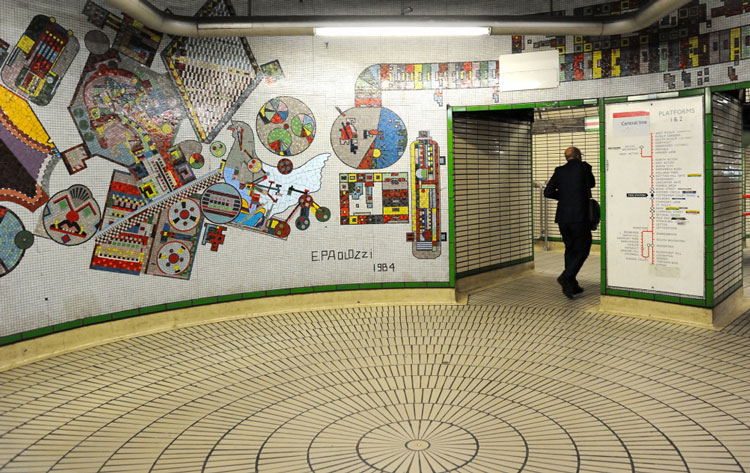Lance Wyman and Eduardo Paolozzi exhibition explores public space design
Metro: Art at Velocity is a new East London exhibition that showcases some of the most memorable designs seen in metro stations and city centres worldwide.

Some of the most distinctive every day designs are those seen on public transport systems. Using London as an example, there is not a commuter in the capital who does not recognise Edward Johnston’s London Underground roundel, the black cab or the red bus as symbols of the city.
East London gallery Bloomberg Space’s latest exhibition Metro: Art at Velocity brings together an artist and a graphic designer to celebrate how design has helped to make both transport systems and public city spaces recognisable. Spread across just two rooms, visitors at first step into the world of Lance Wyman then move into the area dedicated to the late Eduardo Paolozzi.

American designer Wyman is best known for the Mexico 1968 Olympics logo and wayfinding system, alongside those he created for metros such as Mexico City. British sculptor Paolozzi also made an impact on transport through his multi-coloured mosaics that have adorned the walls of Tottenham Court Road since 1986.

The Paolozzi mosaics, Tottenham Court Road Tube station. Photo by Tim Adams.
Rather than a system designed to navigate people, his work created a distinguishing feature for the London tube station, which people living in the city still feel strongly about today. Following the removal of his artworks during the station’s recent expansion, uproar ensued in the form of a public petition, resulting in many of the original mosaics being restored this year.
The thing that connects the two artists’ work is the idea of creating a sense of place, identity and belonging for public spaces, says Wyman.
“This is important for two reasons,” he tells Design Week. “It helps cities become more global, as people who don’t speak the language can get around using icons and colours. Then it also helps the design profession, as projects like this allow designers to complete work that does a job, rather than just projects that are stylised or commercially successful. There’s a real richness of experience to be had from work like this.”

Suitably, the annotations and descriptions are kept to a minimum in the exhibition. Designed and curated by Henry Coleman, the first, larger room uses wall vinyls, sculptures and cabinets to depict Wyman’s various logos and identity systems, while metro station entrances and bus stops have also been recreated. There are short descriptions included within the cabinets, but the visitor booklet and colourful space is predominantly image-led, paying homage to Wyman’s use of icon systems as democratic and non-divisive languages in their own right.
“I’m so happy to see more credence being paid to iconography,” he says. “The iPhone app symbol system does the same thing today that my Mexico ’68 Olympic system did. It’s a way of navigating a real world, and a virtual world.”

The room has been recreated as “things appear on the streets”, adds Wyman, with the designer’s Mexico City Metro worker icons appearing on the walls of the exhibition just as they did in metro stations at the time. This brings a sense of reality to the exhibition, and establishes how, as Wyman says, these projects were very much part of real cityscapes.

Roberts Art Foundaton, Collection ICAEW. Photo by David Morgan.
In the second, smaller room, visitors see miniature, model versions of Tottenham Court Road tube station complete with Paolozzi’s mosaics, original designs that have not been publicly displayed for over 30 years. These sit alongside some of the multimedia artist’s hand-coloured paper collages, graph paper-adorned pixelated patterns, and a giant tapestry, all of which inspired his work in the tube station. Through drawing similarities between Paolozzi’s work across various mediums, visitors are given a snapshot of the artist’s identity and style, and can then see how this was then applied to a public space to give it an identity of its own.
Through displaying these old relics, the exhibition is as much about preservation as it is about highlighting how important these iconic designs are to everyday life, says Wyman.
“It was a real tragedy that so much of Paolozzi’s work was lost when the station was knocked down,” says Wyman. “This is an on-going thing. My grandfather used to take me to New York to see the beautiful, terrazzo columns of the train stations, which were later torn down. It’s good to see London taking care of things now, and start realising these public spaces are important.”

As you walk around the exhibition space, the real thing that connects the two bodies of work is the idea of inclusivity. Whether it’s down to icon systems that have a purpose in guiding passers-by, or distinctive mosaics that simply trigger associations and feelings of happiness, both types of public project encourage tourists and city-livers alike to feel a sense of connection, comfortableness and belonging with a place.
And while imagery will always be more universal than words and their inherent language barriers, this does not diminish the work that will have gone into making these systems so accessible.
“A lot of these cities are very complicated, and through design, you can simplify them,” says Wyman. “To quote my old buddy Albert Einstein, everything should be made as simple as possible, but not simpler. The ‘not simpler’ is the hard part.”
Metro: Art at Velocity runs until 5 August at Bloomberg Space, 50 Finsbury Square, London EC2A 1HD. Entry is free. For more information, head to the Bloomberg Space website.
Discover more
-
Post a comment




